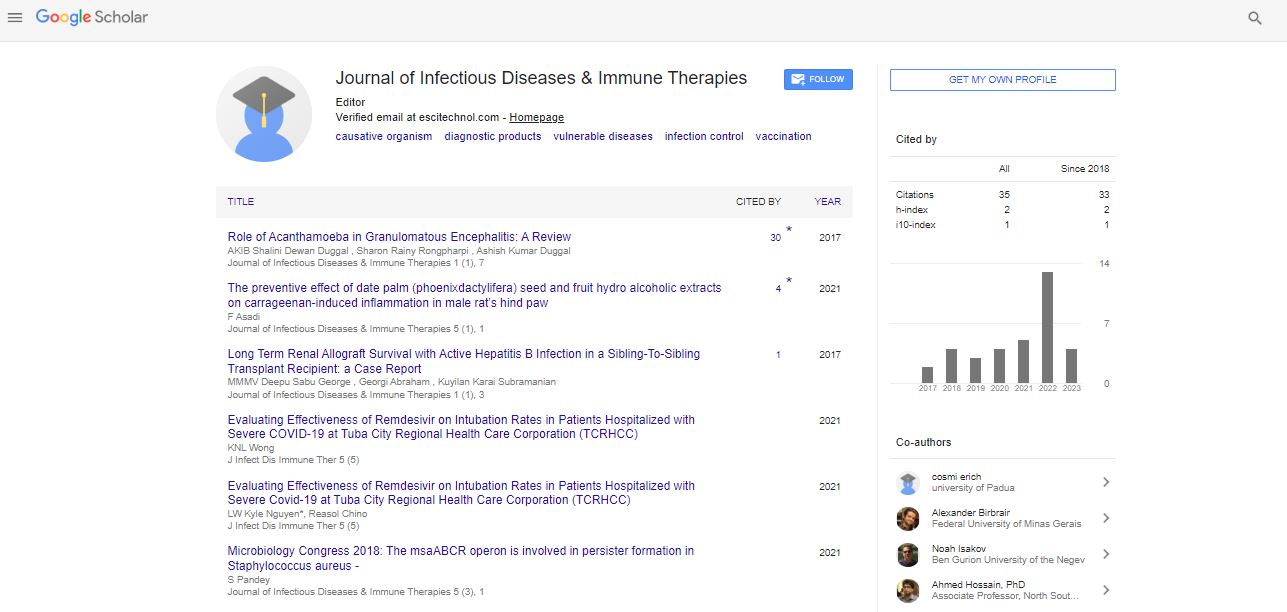Opinion Article, Jbmt Vol: 6 Issue: 2
Periopathogenic Bacteria in Subgingival and Atherosclerotic Plaques-An Age-Related Comparative Analysis
Robin Patel*
Department of Infectious Diseases, Amsterdam University Medical Centres, Amsterdam, the Netherlands
*Corresponding Author:Robin Patel
Department of Infectious Diseases, Amsterdam University Medical Centres,Amsterdam, the Netherlands
Email: robinpatel@gmail.com
Received date: 28 February, 2022; Manuscript No. JIDITH-22-57257;
Editor assigned date: 02 March, 2022; Pre QC No. JIDITH-22-57257(PQ);
Reviewed date: 14 March, 2022; QC No JIDITH-22-57257;
Revised date: 24 March, 2022; Manuscript No. JIDITH-22-57257(R);
Published date: 31 March, 2022; DOI: 10.4172/jidith.1000143.
Citation: Patel R (2022) Periopathogenic Bacteria in Subgingival and Atherosclerotic Plaques-An Age-Related Comparative Analysis. J Infect Dis Immune Ther 6:2
Keywords: Periodontitis; Atherosclerosis
Introduction
In adults, periodontitis and atherosclerosis are both frequent disorders. Periodontitis is a disease that causes tooth loss by destroying the teeth's supporting structures, such as the periodontal ligament, bone, and soft tissues. The infection is a low-grade chronic illness caused by bacteria that live in periodontal pockets. The bacteria that cause periodontal disease are mostly Gram-negative anaerobic bacilli, with some anaerobic cocci and anaerobic spirochetes thrown in for good measure. Atherosclerosis (AS) is a degenerative disease characterized by localized thickening of artery walls. In recent years, there has been a growing body of evidence suggesting that viral mechanisms may play a role in atherosclerosis. There have been reports of a link between a range of infectious pathogens and atherosclerosis. In the 1970s, the Herpes Simplex Virus (HSV) was proposed as a possible causal agent in the development of atherosclerosis in experimental animals.
The Cytomegalovirus (CMV), a member of the herpesviridae family, as well as Gram-negative bacteria such as Chlamydia pneumonia and Helicobacter pylori, have been added to the list of probable infective agents. Epidemiological connections first established the link between oral infections and cardiovascular disorders. Periodontal Disease (PD) and atherosclerosis have also been linked in randomized controlled clinical trials, longitudinal cohort studies, and case-control studies. Studies that used more precise methods to assess periodontal and atherosclerotic condition discovered a clear link between atherosclerosis and periodontal status, as defined by odds ratios. A number of comprehensive publications have shown the presence of periodontal pathogens in atherosclerotic plaques in human atheroma samples, and links between periodontitis and atherosclerosis have also been established in animal models, demonstrating that induced exposure to periodontal pathogenic bacteria was associated with an increase in atheromatous lesions.
A definite link has been shown between the degree of periodontal damage and the presence of periopathogens at this time. However, one aspect of the link between atherosclerosis and oral pathogenic bacteria - the temporal shift of oral microbiota and its possible consequences on AS - has been largely overlooked. It has been shown that oral microbiota changes significantly with age, and periodontal infections have been identified on dental prostheses of elderly edentulous patients. The goal of this investigation was to see if there was a change in the presence of bacterial DNA in the subgingival biofilm and atherosclerotic blood vessels as patients got older. The second purpose was to see if the artery's distance from the oral cavity influenced colonisation. The presence of five main periodontal infections has been determined in oral and artery samples (Porphyromonas gingivalis, Prevotella intermedia, Agreggatibacter actinomycetemcomitans, Tannerella forsythensis andTreponema denticola).
Atherosclerosis
The accumulation of lipids and fibrous components in the major arteries is a gradual condition known as atherosclerosis. Foam cells are cholesterol-engorged macrophages that accumulate subendothelially in the early stages of atherosclerosis. These 'fatty streak' lesions are most commonly detected in the aorta in the first decade of life, the coronary arteries in the second decade, and the cerebral arteries in the third or fourth decades in humans. There are favored sites of lesion formation within the arteries due to changes in blood flow dynamics. Fatty streaks are not clinically significant, but they are precursors to more advanced lesions with lipid-rich necrotic debris and smooth muscle cells accumulating (SMCs). A 'fibrous cap' made up of SMCs and extracellular matrix surrounds a lipid-rich 'necrotic core' in such 'fibrous lesions.' Calcification, ulceration at the luminal surface, and bleeding from tiny vessels that develop into the lesion from the media of the blood vessel wall can all complicate plaques. Although advanced lesions can become large enough to impede blood flow, the most serious clinical complication is an acute occlusion caused by a thrombus or blood clot, which can lead to myocardial infarction or stroke.
The thrombosis is usually linked to the rupture or erosion of the lesion. Animal models, such as rabbits, pigs, non-human primates, and rodents, have substantially elucidated the events of atherosclerosis. Mice lacking apoE or the low-density lipoprotein (LDL) receptor develop progressive lesions and are the most commonly utilised genetic and physiological. The deposition of lipoprotein particles and aggregates in the intima at locations of lesion propensity is the earliest apparent change in the arterial wall following a high-fat, highcholesterol diet. Monocytes can be seen sticking to the endothelium's surface within days or weeks. The monocytes then travel into the intima, where they proliferate, develop into macrophages, and absorb the lipoproteins, creating foam cells. The foam cells die over time, and their lipid-filled contents contribute to the necrotic core of the lesion. Following this, some fatty streaks collect SMCs, which move from the medial layer. Smooth muscle cells secrete fibrous components, which cause occlusive fibrous plaques to form and grow in size. The lesions grow towards the adventitia until they reach a critical point, at which point they extend outwardly and impinge on the lumen. The lesions continue to expand when fresh mononuclear cells from the bloodstream enter at the vessel's shoulder, accompanied by cell proliferation, extracellular matrix synthesis, and extracellular lipid buildup. Lipoproteins or other risk factors are the harmful agents in atherogenesis.
 Spanish
Spanish  Chinese
Chinese  Russian
Russian  German
German  French
French  Japanese
Japanese  Portuguese
Portuguese  Hindi
Hindi 